Konami has released many Special Summoning techniques from Ritual, Fusion, Synchro, Xyz, Pendulum and Links. Over the years, the mechanics have evolved, giving new interaction and play styles. Sometimes, the anime provides these evolutions semi-official terms. Other times, they are treated as a gimmick. This article will be one of the six-part series looking at the evolution for each summoning mechanic. Some of these evolutions haven’t appeared in the real game yet. I will be using terms from the anime to describe the evolutions. This article will assume you know how each summoning mechanic works.

Synchro Summon
Synchro Summon was the first Special Summon mechanic that wasn't part of the OG series. The introduction of Synchro massacred the Fusion Deck with no limit and turned it into the Extra Deck with 15 cards limit. It also introduced the Tuner subtype to the game. Being more consistent, generic and powerful than Fusions and Rituals at the time, it quickly replaced both Fusions and Rituals as the go-to summoning mechanic. Despite this, there are some players who argue that this mechanic did not age well compared to the other mechanics.
Strong First Impression (2008)
 In 2008, Konami debuted Synchro to the world. Right off the bat, it's clear that Synchro is here to replace both Fusions and Rituals. Not only were the monsters stronger (ATK and effect wise), but they were also generic. This allowed players to splash them into their Extra Deck easily. Players would continue to run most of these synchros throughout the synchro era (Stardust Dragon, Goyo Guardian, Red Dragon Archfiend, etc). In fact, Goyo Guardian was so strong that it was banned.
In 2008, Konami debuted Synchro to the world. Right off the bat, it's clear that Synchro is here to replace both Fusions and Rituals. Not only were the monsters stronger (ATK and effect wise), but they were also generic. This allowed players to splash them into their Extra Deck easily. Players would continue to run most of these synchros throughout the synchro era (Stardust Dragon, Goyo Guardian, Red Dragon Archfiend, etc). In fact, Goyo Guardian was so strong that it was banned.
The first waves of Synchro monsters released include Stardust Dragon, Avenging Knight Parshath, Nitro Warrior, Red Dragon Archfiend, Goyo Guardian, Magical Android and Thought Ruler Archfiend.
Tuner's Synched Effects (2008)
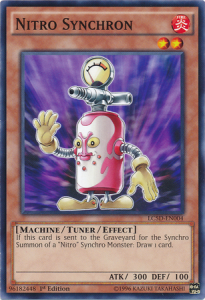 When Konami debuted synchros in 2008, they also debuted a handful of tuner monsters. These tuners have random effects that don't really facilitate Synchro Summoning. However, despite this, many Tuners released early in the Synchro eras have effects that trigger if used as Synchro Materials (e.g. Nitro Synchron and Sinister Sproket).
When Konami debuted synchros in 2008, they also debuted a handful of tuner monsters. These tuners have random effects that don't really facilitate Synchro Summoning. However, despite this, many Tuners released early in the Synchro eras have effects that trigger if used as Synchro Materials (e.g. Nitro Synchron and Sinister Sproket).
Konami would continue to use this design formula for many of their tuners, including Tuningware and Windwitch - Snow Bell.
Protection/Stalling (2008)
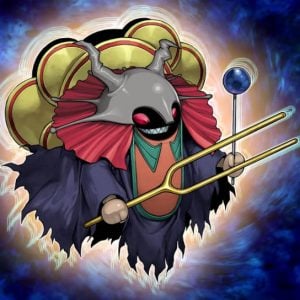 The first wave of Tuners introduced in 2008 doesn't actually have the swarming capability of many modern Tuners. Mind Master can Special Summon a Psychic monster from the Deck. However, that effect is more so that the player has the right levels rather than swarming the field. So instead, many Tuners in the first wave relied on effects that ensure they'll survive till next turn (e.g. Krebon's attack negation or Dark Resonator's Destruction Protection).
The first wave of Tuners introduced in 2008 doesn't actually have the swarming capability of many modern Tuners. Mind Master can Special Summon a Psychic monster from the Deck. However, that effect is more so that the player has the right levels rather than swarming the field. So instead, many Tuners in the first wave relied on effects that ensure they'll survive till next turn (e.g. Krebon's attack negation or Dark Resonator's Destruction Protection).
As the game got faster and monsters' removals aren't just limited to battle, Konami has slowly abandoned this gimmick. The most notable archetype that uses this gimmick is Ice Barriers, and we all know how well they turned out.
Negation (2008)
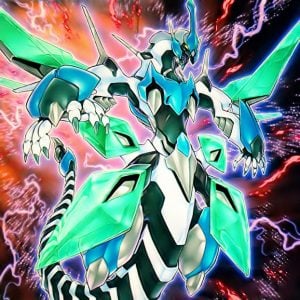 In the first wave of synchro support in 2008, Konami released Stardust Dragon. It has a strong effect that allows the player to tribute itself to negate destruction effects. It can revive itself during the End Phase. Stardust Dragon set the formula for future Extra Deck monsters (not just Synchro) with far more generic negation effects.
In the first wave of synchro support in 2008, Konami released Stardust Dragon. It has a strong effect that allows the player to tribute itself to negate destruction effects. It can revive itself during the End Phase. Stardust Dragon set the formula for future Extra Deck monsters (not just Synchro) with far more generic negation effects.
Konami would later create synchro monsters that sports similar effects without the cost of tributing itself (e.g. Clearwing Dragon and Crystal Wing Dragon).
Summoned Trigger Effects (2008)
I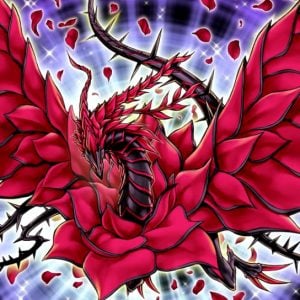 n the mid-2008, Black Rose Dragon debuted. This dragon is the first instance of a synchro summons triggered effect, and boy, did it delivered. Black Rose Dragon was the first apparent sign of power creeping in the synchro era. This monster is Dark Hole + Heavy Storm combined into one. As the game was slower back then and swarming the field isn't that easy, its effect of resetting the field can quickly change the direction of the game. This effect was so powerful that Black Rose Dragon was limited for a while. Other synchro monsters with summoning trigger effects include Tempest Magician and Doomkaiser Dragon.
n the mid-2008, Black Rose Dragon debuted. This dragon is the first instance of a synchro summons triggered effect, and boy, did it delivered. Black Rose Dragon was the first apparent sign of power creeping in the synchro era. This monster is Dark Hole + Heavy Storm combined into one. As the game was slower back then and swarming the field isn't that easy, its effect of resetting the field can quickly change the direction of the game. This effect was so powerful that Black Rose Dragon was limited for a while. Other synchro monsters with summoning trigger effects include Tempest Magician and Doomkaiser Dragon.
Konami would later continue with this type of effect with the release of Ravenous Crocodragon Archethys and Fabled Andraith.
Archetype Synchros (2008)
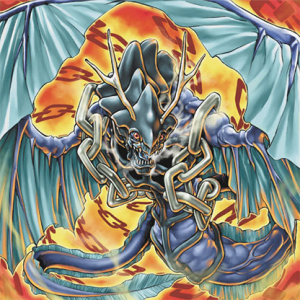 In the mid-2008, Konami released Iron Chain Dragon. It's a Level 6 synchro monsters belonging to an archetype with an identity crisis. This monster is the first synchro monster released belonging to an archetype, not counting "Goyo," as it wasn't originally an archetype. Being the first boss synchro monster for an archetype, its effect is unimpressive as it doesn't really help its own archetype much. However, it's a pretty good beatstick and generic enough for players to splash into their extra deck.
In the mid-2008, Konami released Iron Chain Dragon. It's a Level 6 synchro monsters belonging to an archetype with an identity crisis. This monster is the first synchro monster released belonging to an archetype, not counting "Goyo," as it wasn't originally an archetype. Being the first boss synchro monster for an archetype, its effect is unimpressive as it doesn't really help its own archetype much. However, it's a pretty good beatstick and generic enough for players to splash into their extra deck.
Konami would later create more archetype's synchro monsters. Some archetype synchro boss monsters include Karakuri, Ice Barrier, and Blackwing.
Level Manipulation (2008)
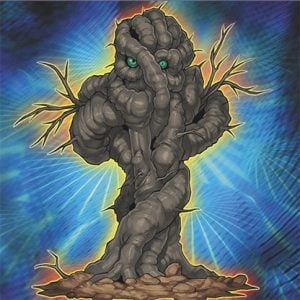 In the mid-2008, Konami released Copy Plant. Copy Plant has an effect that copies the level of another plant monster on the field. The changing of the level enables the player to access different levels of Synchro monsters. Copy Plant is the first tuner with this effect, and since then, Konami has often include level manipulation effects for Tuners in a synchro archetypes.
In the mid-2008, Konami released Copy Plant. Copy Plant has an effect that copies the level of another plant monster on the field. The changing of the level enables the player to access different levels of Synchro monsters. Copy Plant is the first tuner with this effect, and since then, Konami has often include level manipulation effects for Tuners in a synchro archetypes.
Some example of Tuners with level manipulation abilities includes Spore, Infernity Avenger, Uni-Zombie, Speedroid Red-Eyed Dice, etc.
Special Summoning Tuners (2008)
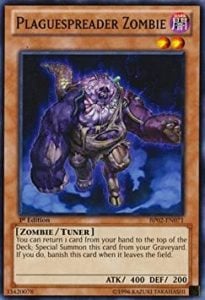 In mid-2008, Plaguespreader Zombie debuted. It's is a Level 2 Zombie-Type Tuner monster with the ability to revive itself from the Grave by returning one card from your hand to the Deck. This is the first instance where a Tuner Monster has an effect that swarms itself onto the field to facilitate Synchro Summoning as many Tuners beforehand doesn't have any swarming capability. This monster sets the beginning of the "combo gameplay" that synchros are infamous for. Many modern Tuners nowadays have the capacity to Special Summon itself to the field.
In mid-2008, Plaguespreader Zombie debuted. It's is a Level 2 Zombie-Type Tuner monster with the ability to revive itself from the Grave by returning one card from your hand to the Deck. This is the first instance where a Tuner Monster has an effect that swarms itself onto the field to facilitate Synchro Summoning as many Tuners beforehand doesn't have any swarming capability. This monster sets the beginning of the "combo gameplay" that synchros are infamous for. Many modern Tuners nowadays have the capacity to Special Summon itself to the field.
Some Tuner Monsters with this effect includes Reptilianne Lamia, Glowup Bulb, Windwitch - Snow Bell and Quickdraw Synchron.
Random Tuners for Archetypes (2008)
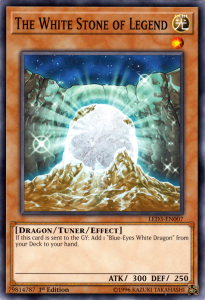 In mid-2008, Konami debuted the monster, The White Stone of Legend. It's a level 1 Tuner Monster belonging to the Blue-Eyes White Dragon archetype. However, the monster was released at the time where Blue-Eyes had no synchro monsters whatsoever (Note: Blue-Eyes White Dragon wasn't a Blue Eyes archetype then). The monster itself was used mostly for its effect to search Blue-Eyes White Dragon from the Deck. As for why it's a Tuner, Konami did it to give players the option to perform a Synchro Summon.
In mid-2008, Konami debuted the monster, The White Stone of Legend. It's a level 1 Tuner Monster belonging to the Blue-Eyes White Dragon archetype. However, the monster was released at the time where Blue-Eyes had no synchro monsters whatsoever (Note: Blue-Eyes White Dragon wasn't a Blue Eyes archetype then). The monster itself was used mostly for its effect to search Blue-Eyes White Dragon from the Deck. As for why it's a Tuner, Konami did it to give players the option to perform a Synchro Summon.
Since then, Konami has often made certain monsters in an archetype a Tuner despite that archetype not having synchro monsters. The reasons range from giving players the option to perform a synchro summon to lore reasons. Example of these includes Ghost Girls, Predaplant Banksiogre (anime reasons), Infernoid Decatron, Herald of Orange Light (Before Herald of Arc Light debuted) and Shaddoll Falco.
Archtype Specification (2008)
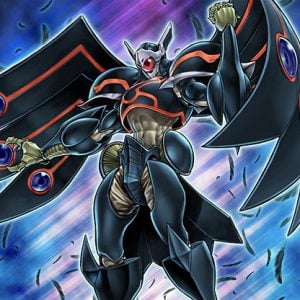 In late 2008, OCG saw the release of Blackwing Armor Master. It's a Level 8 Synchro Monster belonging to the once-powerful Blackwing archetype known for its swarming capability. Blackwing Armor Master is a 2500 ATK monster with the effect of reducing a monster's ATK to 0. Early Synchro Monsters often have generic summoning conditions, requires specific Tuner monsters (e.g. Nitro Warrior) or merely needs a Tuner/non-tuners from a specific Type/Attribute (e.g. Queen of Thorns). However, Blackwing Armor Master is the first Synchro monster with the requirement of having an "archetype monster Tuner" as its summoning condition.
In late 2008, OCG saw the release of Blackwing Armor Master. It's a Level 8 Synchro Monster belonging to the once-powerful Blackwing archetype known for its swarming capability. Blackwing Armor Master is a 2500 ATK monster with the effect of reducing a monster's ATK to 0. Early Synchro Monsters often have generic summoning conditions, requires specific Tuner monsters (e.g. Nitro Warrior) or merely needs a Tuner/non-tuners from a specific Type/Attribute (e.g. Queen of Thorns). However, Blackwing Armor Master is the first Synchro monster with the requirement of having an "archetype monster Tuner" as its summoning condition.
Konami hasn't used this gimmick that often. You see it here and there once in a while. However, Konami often likes to have archetype's synchro monsters using specific Types/Attribute Tuners rather than specific Archetype Named Tuner. Examples of synchro monsters that require specific archetype monsters include Genex Ally Triforce, Atomic Scrap Dragon, Legendary Six Samurai - Shi En (Non-Tuner) and Superheavy Samurai Steam Train King.
Swarming Fodders (2008)
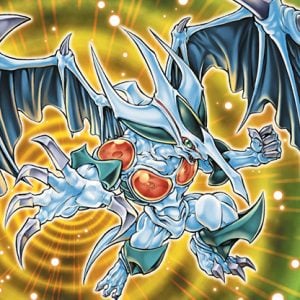 In late 2008, Konami released Debris Dragon, Alien Ammonite, Twilight Rose Knight and Black Salvo. They're Tuners that Special Summons a monster from other places to perform a Synchro Summon. However, they do come with restrictions. For example, Debris Dragon comes with the restrictions of that the monster can only be used for the synchro summoning of a Dragon-Type Synchro monster and that the Level of the synchro material cannot be Level 4. It's the first Tuner-Monster to include the ability to Special Summon a fodder from other places to facilitate Synchro Plays.
In late 2008, Konami released Debris Dragon, Alien Ammonite, Twilight Rose Knight and Black Salvo. They're Tuners that Special Summons a monster from other places to perform a Synchro Summon. However, they do come with restrictions. For example, Debris Dragon comes with the restrictions of that the monster can only be used for the synchro summoning of a Dragon-Type Synchro monster and that the Level of the synchro material cannot be Level 4. It's the first Tuner-Monster to include the ability to Special Summon a fodder from other places to facilitate Synchro Plays.
Konami has continued to use this type of effect for many modern Tuners. It's so common nowadays that it's honestly strange that this type of effects wasn't common for Synchros in the beginning. The release of these effects caused Konami to abandon many of the early Tuner effects that protect themselves for the next turn, and instead, adopt a more "quick one turn synchro summoning" strategy. Some Tuners that Special Summons synchro material fodders include Blackwing - Blizzard The Far North, Black Salvo, Cherry Inmato, Twilight Rose Knight, Adamancipator Analyser, etc.
Assault Mode (2008)
In late 2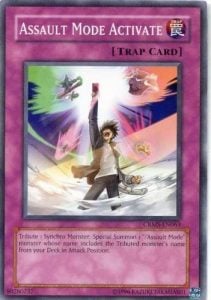 008, Konami released Assault Mode Activate. It's a Trap Card that tributes a Synchro Monster to Special Summon the "Assault" form of the monster from your Deck to the Field. The Assault form of those monsters is an upgraded version of the monster and are genuinely more powerful. However, it does come with specific restriction including that Assault Mode can only summon the Assault form from the Deck. This gimmick was quickly abandoned until it was randomly supported again in 2019 with the release of T.G. Halberd Cannon/Assault Mode.
008, Konami released Assault Mode Activate. It's a Trap Card that tributes a Synchro Monster to Special Summon the "Assault" form of the monster from your Deck to the Field. The Assault form of those monsters is an upgraded version of the monster and are genuinely more powerful. However, it does come with specific restriction including that Assault Mode can only summon the Assault form from the Deck. This gimmick was quickly abandoned until it was randomly supported again in 2019 with the release of T.G. Halberd Cannon/Assault Mode.
Some Assault Mode monsters include Arcanite Magician, Colossal Fighter/Assault Mode, Doomkaiser Dragon/Assault Mode, Hyper Psychic Blaster/Assault Mode, Red Dragon Archfiend/Assault Mode, Stardust Dragon/Assault Mode and T.G. Halberd Cannon/Assault Mode.
Restrictive Materials Effects (2008)
Konami released Royal Swamp Eel in late 2008. It's a Tuner monster with a single effect that forces the player to ONLY use Fish-Type as Synchro Materials. Now this card is bad. Thankfully, other Tuners with these restrictions usually include other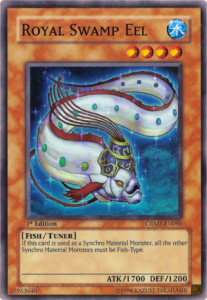 effects that make these restrictions understandable. Konami continued with this gimmick up to 2014, where they eventually abandoned this gimmick altogether. They did however evolved this gimmick by creating Tuners that can only be used to Synchro Summon certain monsters (e.g. Wind Attribute, Specific Types, etc).
effects that make these restrictions understandable. Konami continued with this gimmick up to 2014, where they eventually abandoned this gimmick altogether. They did however evolved this gimmick by creating Tuners that can only be used to Synchro Summon certain monsters (e.g. Wind Attribute, Specific Types, etc).
Examples of monsters with this restrictive ability include Fishborg Blaster, Vanadis of the Nordic Descendant, Mono Synchron and Blackwing Steam the Cloak.
Opponent's Turn Synchro Summon (2008)
Ko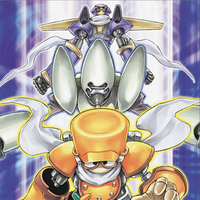 nami released Urgent Tuning in 2008. It's a Trap Card that enables the player to Synchro Summon using the monster on your field in the opponent's turn (since it's a Trap Card). This is the first instance where players can perform a synchro summon in the opponent's turn. Konami would later reimplement this gimmick for Formula Synchron. In fact, the entire Crystron Tuners have this gimmick.
nami released Urgent Tuning in 2008. It's a Trap Card that enables the player to Synchro Summon using the monster on your field in the opponent's turn (since it's a Trap Card). This is the first instance where players can perform a synchro summon in the opponent's turn. Konami would later reimplement this gimmick for Formula Synchron. In fact, the entire Crystron Tuners have this gimmick.
Floating Effects (2009)
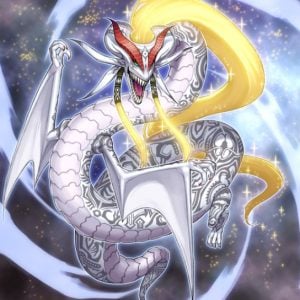 In mid-2009, Konami released Ancient Sacred Wyvern. It's a Level 7 synchro monster that can revive itself from the Graveyard by paying 1000 LP if it's destroyed by battle. Konami would often place floating effects on their synchro monsters. In fact, Konami has further evolved this gimmick by sometimes enabling the players to revive the synchro materials so the players can summon a different synchros next turn.
In mid-2009, Konami released Ancient Sacred Wyvern. It's a Level 7 synchro monster that can revive itself from the Graveyard by paying 1000 LP if it's destroyed by battle. Konami would often place floating effects on their synchro monsters. In fact, Konami has further evolved this gimmick by sometimes enabling the players to revive the synchro materials so the players can summon a different synchros next turn.
Synchro monsters with this ability include Battlewasp - Azusa The Ghost Bow, Graydle Dragon, Colossal Fighter, Sun Dragon Inti, etc.
Graveyard as Synchro Materials (2009)
In mid-2009, 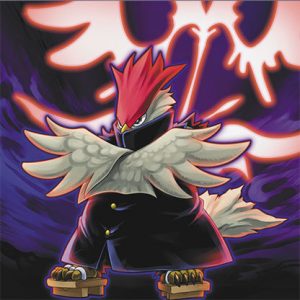 OCG saw the release of Blackwing - Vayu the Emblem of Honor. It's a low-level Tuner Monster that cannot be used as a synchro material on the field. However, what makes it unique is that the player can banish itself and other Blackwing monsters from the graveyard to Special Summons a synchro monster from the Extra Deck. It should be noted that this summoning doesn't count as a Synchro Summon.
OCG saw the release of Blackwing - Vayu the Emblem of Honor. It's a low-level Tuner Monster that cannot be used as a synchro material on the field. However, what makes it unique is that the player can banish itself and other Blackwing monsters from the graveyard to Special Summons a synchro monster from the Extra Deck. It should be noted that this summoning doesn't count as a Synchro Summon.
Blackwing - Vayu the Emblem is the ONLY Tuner monster in the game that uses synchro materials from the graveyard to summon a Synchro Monster from the Extra Deck. Konami has yet to expand on this gimmick.
Majestic Upgrade (2009)
I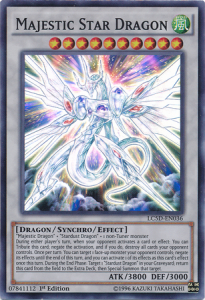 n mid-2009, Konami released Majestic Star Dragon. A Level 10 synchro monster that is the upgraded Majestic Form of Stardust Dragon. It has a powerful effect and sports a whopping 3800 ATK stat. The problem is that it only lasts for one turn, and the summoning of this monster is quite tricky. It requires three synchro materials (Level 1 Majestic Dragon + the Synchro Dragon + One additional Synchro Material).
n mid-2009, Konami released Majestic Star Dragon. A Level 10 synchro monster that is the upgraded Majestic Form of Stardust Dragon. It has a powerful effect and sports a whopping 3800 ATK stat. The problem is that it only lasts for one turn, and the summoning of this monster is quite tricky. It requires three synchro materials (Level 1 Majestic Dragon + the Synchro Dragon + One additional Synchro Material).
After the release of Majestic Red Dragon in 2010, Konami has abandoned this theme altogether. However, seeing how Assault Mode randomly has received support, Konami may revisit this gimmick as it was quite a notable plot point in the 5D Anime.
However, some may argue that this is the first instance where Konami intentionally promote "Synchro Climbing."
Synchro Material Substitution (2009)
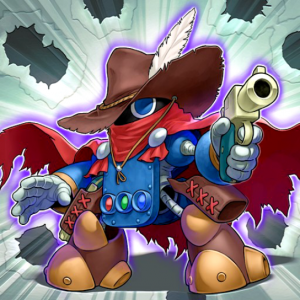 Konami released Quickdraw Synchron in mid-2009. Quickdraw Synchron quickly became a staple in Synchro Decks in general. Its ability to Special Summon itself and combined with the high level enables players to Synchro Summon high-level Synchro Monsters that use a "Synchron" monster as material. However, what makes this card unique at the time was that it's the first time a monster has an effect that substitutes itself as one of the Synchro Materials. Many of the "Warrior" synchros often requires specific Tuner monsters (e.g. Nitro Warrior requires Nitro Synchron and Junk Warrior requires Junk Synchron). Quickdraw Synchron singlehandedly tied the Synchron archetype together by enabling the player to replace the specific summoning condition with it.
Konami released Quickdraw Synchron in mid-2009. Quickdraw Synchron quickly became a staple in Synchro Decks in general. Its ability to Special Summon itself and combined with the high level enables players to Synchro Summon high-level Synchro Monsters that use a "Synchron" monster as material. However, what makes this card unique at the time was that it's the first time a monster has an effect that substitutes itself as one of the Synchro Materials. Many of the "Warrior" synchros often requires specific Tuner monsters (e.g. Nitro Warrior requires Nitro Synchron and Junk Warrior requires Junk Synchron). Quickdraw Synchron singlehandedly tied the Synchron archetype together by enabling the player to replace the specific summoning condition with it.
Since then, Konami has only released four additional substitutes Synchro Materials. Those cards are Junk Anchor, Righty Driver, and Vanadis of the Nordic Ascendant.
Controlling Opponent's Monster (2009)
Kona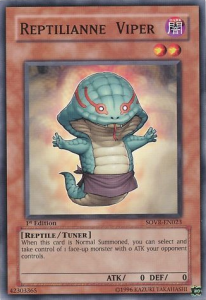 mi debuted Reptilianne Viper in mid-2009. It's a Tuner monster with the ability to take control of an opponent's 0 ATK monster, which enables the player to use it for synchro summoning. This is the only Tuner monster in the entire game that controls another opponent's monster to use as a synchro material. Psychic Jumper has a similar effect, but it acts more like trading than outright taking the opponent's monster. This sort of playstyle isn't unique, as players have used similar cards like Mind Control to steal an opponent's monsters to perform a Synchro Summon.
mi debuted Reptilianne Viper in mid-2009. It's a Tuner monster with the ability to take control of an opponent's 0 ATK monster, which enables the player to use it for synchro summoning. This is the only Tuner monster in the entire game that controls another opponent's monster to use as a synchro material. Psychic Jumper has a similar effect, but it acts more like trading than outright taking the opponent's monster. This sort of playstyle isn't unique, as players have used similar cards like Mind Control to steal an opponent's monsters to perform a Synchro Summon.
As mentioned before, Konami hasn't really revisited this gimmick. However, Graydle sports similar gameplay to Reptilianne Viper, but it doesn't really use the monsters as synchro materials. Konami did release Superheavy Samurai Battleball, which acts like a Super Polymerization for Synchros.
Supporting Other Types (2009)
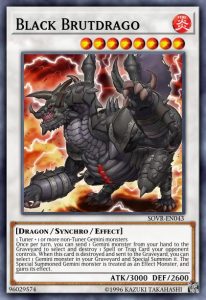 In mid-2009, Konami released Black Brutdrago. It's a Synchro Monster that supports the Gemini-Subgroup explicitly. Since then, Konami has released several Synchro Monsters designed to help specific subgroup and Monster Card Types. For example, Rituals have Herald of the Arc Light, Fusions have Muddy Mudragon and Old Entity Cthuguam, Xyz have Old Entity Cthuguam, etc.
In mid-2009, Konami released Black Brutdrago. It's a Synchro Monster that supports the Gemini-Subgroup explicitly. Since then, Konami has released several Synchro Monsters designed to help specific subgroup and Monster Card Types. For example, Rituals have Herald of the Arc Light, Fusions have Muddy Mudragon and Old Entity Cthuguam, Xyz have Old Entity Cthuguam, etc.
Skipping the Tuning Process (2009)
In late-2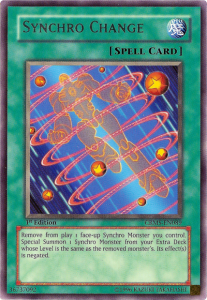 009, Konami released Synchro Change. It's a Spell Card that banishes a Synchro Monster you control to Special Summon another one with the same level from the Extra Deck. The problem is that the new Synchro will have its effect negated and the summon isn't counted as a Synchro Summon. This means the player cannot revive the Synchro Monster if it gets sent to the graveyard as it was never properly Synchro Summoned. Konami would expand on this gimmick of skipping the tuning process with cards like Starlight Road that was a staple during the time where Heavy Storm and Black Rose Dragon were common.
009, Konami released Synchro Change. It's a Spell Card that banishes a Synchro Monster you control to Special Summon another one with the same level from the Extra Deck. The problem is that the new Synchro will have its effect negated and the summon isn't counted as a Synchro Summon. This means the player cannot revive the Synchro Monster if it gets sent to the graveyard as it was never properly Synchro Summoned. Konami would expand on this gimmick of skipping the tuning process with cards like Starlight Road that was a staple during the time where Heavy Storm and Black Rose Dragon were common.
Konami would continue this gimmick with the release of Starlight Road, Shadow Impulse and Synchro Transcend.
Using Hand as Synchro Materials (2009)
Eccentric Boy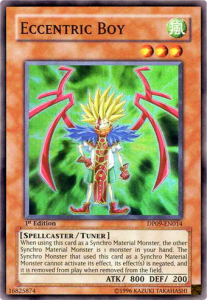 debuted in 2009. It's a Level 3 Tuner that doesn't have an effect that Special Summon itself or Special Summon fodder onto the field. However, it does have the effect of enabling the player to use another from their hand to perform a Synchro Summon.
debuted in 2009. It's a Level 3 Tuner that doesn't have an effect that Special Summon itself or Special Summon fodder onto the field. However, it does have the effect of enabling the player to use another from their hand to perform a Synchro Summon.
Since then, Konami has made Tuners that can use their hand as part of the material to perform a Synchro Summon. These monsters include Mara of the Nordic Alfar, Malefic Parallel Gear, T.G. Cyber Magician, Tatsunoko and Tatsunecro.
Tuner Handtraps (2010)
Mid-2010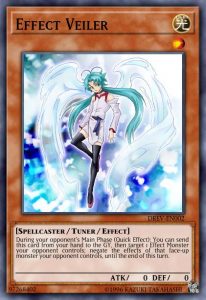 saw the release of Effect Veiler. It's a Level 1 Tuner monsters that have the effect of negating a monster's effect during the opponent's main phase. Being a Tuner, it also enables the player to use it as a synchro material. However, it has no way of Special Summoning itself from the hand. Effect Veiler set the formula for many modern hand traps being a Tuner. The entire Ghost Girl line is comprised of Tuner monsters.
saw the release of Effect Veiler. It's a Level 1 Tuner monsters that have the effect of negating a monster's effect during the opponent's main phase. Being a Tuner, it also enables the player to use it as a synchro material. However, it has no way of Special Summoning itself from the hand. Effect Veiler set the formula for many modern hand traps being a Tuner. The entire Ghost Girl line is comprised of Tuner monsters.
Other hand traps that are also a Tuner include Ash Blossom & Joyous Spring, Ghost Belle & Haunted Mansion, Ghost Mourner & Moonlit Chill, Ghost Ogre & Snow Rabbit, Ghost Reaper & Winter Cherries and Ghost Sister & Spooky Dogwood.
Fusion Support (2010)
T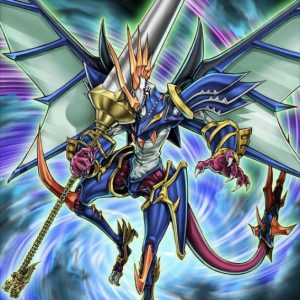 o promote the 10th Anniversary movie, Konami decided to mixed Synchros with Fusions with the release of Miracle Synchro Fusion, Ultimate Axon Kicker and Dragon Knight Draco-Equiste in mid-2010. Both Dragon Knight Draco-Equiste and Ultimate Axon Kicker are fusion monsters that require the player to fuse a Synchro monster with another monster.
o promote the 10th Anniversary movie, Konami decided to mixed Synchros with Fusions with the release of Miracle Synchro Fusion, Ultimate Axon Kicker and Dragon Knight Draco-Equiste in mid-2010. Both Dragon Knight Draco-Equiste and Ultimate Axon Kicker are fusion monsters that require the player to fuse a Synchro monster with another monster.
Konami would later expand on this gimmick with the release of Supreme Arcanite Magician, Naturia Gaiastrio, Goyo Emperor, Gaia Drake, the Universal Force, Elder Entity Norden, Elder Entity N'tss.
This gimmick is often clunky and needless to say, many of these fusions never saw competitive success. The only one who saw use were Elder Entity Norden, but people simply cheat it out with Instant Fusion.
Synchro Tuners (2010)
 Konami released Formula Synchron in late 2010. It's a Level 2 Synchro Monster that is also a Tuner Monster. This monster alone created the other synchro summon subgroup (e.g. Accel Synchro). Since then, it's not uncommon for Konami to make modern Synchro Monsters also a Tuner monster.
Konami released Formula Synchron in late 2010. It's a Level 2 Synchro Monster that is also a Tuner Monster. This monster alone created the other synchro summon subgroup (e.g. Accel Synchro). Since then, it's not uncommon for Konami to make modern Synchro Monsters also a Tuner monster.
Other synchro monsters that are also Tuners include T.G. Recipro Dragonfly, Puralis, the Purple Pyrotile, Coral Dragon, Accel Synchron, etc.
Accel Synchro (2010)
Late 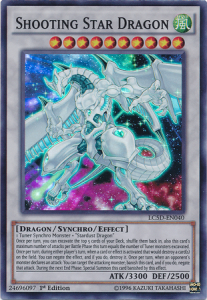 2010, Konami released Shooting Star Dragon. It's the first Accel Synchro monster in the game. Accel Synchro is a term coined by the anime that involves the player to Synchro Summoned by using 1 Tuner Synchro Monster and 1 or more non-Tuner Synchro Monsters.
2010, Konami released Shooting Star Dragon. It's the first Accel Synchro monster in the game. Accel Synchro is a term coined by the anime that involves the player to Synchro Summoned by using 1 Tuner Synchro Monster and 1 or more non-Tuner Synchro Monsters.
Konami has expanded on this concept with the release of Shooting Quasar Dragon, Stardust Warrior, Crystron Phoenix and T.G. Blade Blaster.
Double Tuning (2010)
In 20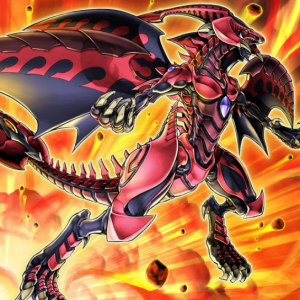 10, Konami released Red Nova Dragon. It's a synchro monster that sports a whopping 3500 ATK with a destruction immunity effect. It's also the first Synchro monsters that require the player to perform a "Double Tuning". Double Tuning involves the player using two Tuners rather than just one to perform a Synchro Summon. Konami would later evolve this gimmick even further with Triple Tuning.
10, Konami released Red Nova Dragon. It's a synchro monster that sports a whopping 3500 ATK with a destruction immunity effect. It's also the first Synchro monsters that require the player to perform a "Double Tuning". Double Tuning involves the player using two Tuners rather than just one to perform a Synchro Summon. Konami would later evolve this gimmick even further with Triple Tuning.
Konami has expanded on this gimmick with the release of Crystron Quariongandrax, Hot Red Dragon Archfiend King Calamity, Tyrant Red Dragon Archfiend and XX-Saber Gottoms (you can use more than one Tuners).
Token Generation (2010)
La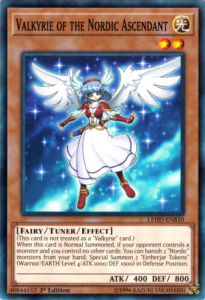 te 2010 saw the release of Valkyrie of the Nordic Ascendant. It's a Tuner with the ability to spawn tokens to perform a Synchro Summon. Using Tuners to perform a Synchro Summon isn't a new concept, but this is the first Tuner monster to take advantage of this concept and made it as part of its effect. Konami has later expanded on this gimmick by creating Tuners that can generate tokens. However, they have since abandoned this concept in 2016 with the release of Blackwing - Gofu the Vague Shadow. This is party because tokens generation is extremely powerful in this modern era and 30% of Tuners that can generate tokens are banned.
te 2010 saw the release of Valkyrie of the Nordic Ascendant. It's a Tuner with the ability to spawn tokens to perform a Synchro Summon. Using Tuners to perform a Synchro Summon isn't a new concept, but this is the first Tuner monster to take advantage of this concept and made it as part of its effect. Konami has later expanded on this gimmick by creating Tuners that can generate tokens. However, they have since abandoned this concept in 2016 with the release of Blackwing - Gofu the Vague Shadow. This is party because tokens generation is extremely powerful in this modern era and 30% of Tuners that can generate tokens are banned.
Tuners that can generate tokens include Blackwing - Gofu the Vague Shadow, Mare Mare, Mecha Phantom Beast O'Lion, Scapeghost, etc.
Delta Accel Synchro/Limit Over Accel Synchro (2011)
In 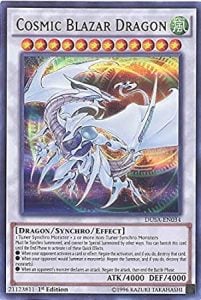 2011, Konami released the first Delta Accel Synchro Monster, T.G. Halberd Cannon and Shooting Quasar Dragon. The terms, Delta Accel Synchro and Limit Over Accel Synchro, are coined by the anime. Unlike Accel Synchro, Delta Accel Synchro and Limit Over Accel Synchro requires at least three synchro materials, 1 Synchro Tuner + 2 Synchro Non-Tuners. Konami forgot about this gimmick until they released Cosmic Blazer Dragon and Stardust Sifr Divine Dragon.
2011, Konami released the first Delta Accel Synchro Monster, T.G. Halberd Cannon and Shooting Quasar Dragon. The terms, Delta Accel Synchro and Limit Over Accel Synchro, are coined by the anime. Unlike Accel Synchro, Delta Accel Synchro and Limit Over Accel Synchro requires at least three synchro materials, 1 Synchro Tuner + 2 Synchro Non-Tuners. Konami forgot about this gimmick until they released Cosmic Blazer Dragon and Stardust Sifr Divine Dragon.
FLIP Monster Tuners (2014)
Synchro w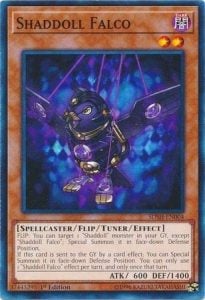 ould see no upgrade and evolution for four years (partly due to Konami focusing on Xyz) until 2014 during the Arc-V era when they released Shaddoll - Falco. It's the first Tuner monster that is also a Flip monster. Konami hasn't really expanded on this gimmick as the only other Tuner that is also a FLIP monster in the game is Scapeghost. The reason for this is probably because Synchros are known for their fast and combo orientated gameplay, whereas FLIP monsters contradict that. Another reason is also probably because FLIP monsters have been losing favor since the gameplay nowadays is a lot faster than what it used to be.
ould see no upgrade and evolution for four years (partly due to Konami focusing on Xyz) until 2014 during the Arc-V era when they released Shaddoll - Falco. It's the first Tuner monster that is also a Flip monster. Konami hasn't really expanded on this gimmick as the only other Tuner that is also a FLIP monster in the game is Scapeghost. The reason for this is probably because Synchros are known for their fast and combo orientated gameplay, whereas FLIP monsters contradict that. Another reason is also probably because FLIP monsters have been losing favor since the gameplay nowadays is a lot faster than what it used to be.
One Card Engine (2014)
Th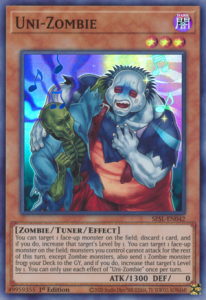 e release of Uni-Zombie in 2014 saw the beginning of Konami pushing for one card engine for Synchros. Historically, we always have had one card that can perform a Synchro Summon (e.g. Rescue Cat and Dark Grepher). However, they weren't Tuners and most of the time, Konami tried their best to hit it. The release of Uni-Zombie was the first time Konami embraced the one card engine for Synchros, and since then they have deliberately created archetype one card engine to support synchro plays.
e release of Uni-Zombie in 2014 saw the beginning of Konami pushing for one card engine for Synchros. Historically, we always have had one card that can perform a Synchro Summon (e.g. Rescue Cat and Dark Grepher). However, they weren't Tuners and most of the time, Konami tried their best to hit it. The release of Uni-Zombie was the first time Konami embraced the one card engine for Synchros, and since then they have deliberately created archetype one card engine to support synchro plays.
Some example of one card engine for synchros includes Windwitch, Terrortop, Dark Contract, etc.
Inheriting Effects (2014)
In 2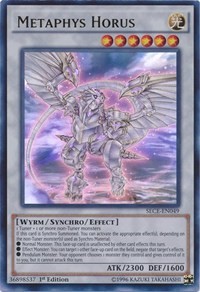 014, Metaphys Horus was released. It's a Synchro monster that inherits the effect depending on the synchro material used for its Synchro Summon. Konami hasn't really expanded on this gimmick much. The only other Synchro Monster with similar effect to is Shiranui Squiresaga and Enlightenment Paladin. However, they did evolve this gimmick further in 2015 with the release of Chaofeng, Phantom of the Yang Zing. Rather than inheriting specific effects, it instead has an effect that prevented the effects of certain attribute depending on the attribute used for its Synchro Summoning.
014, Metaphys Horus was released. It's a Synchro monster that inherits the effect depending on the synchro material used for its Synchro Summon. Konami hasn't really expanded on this gimmick much. The only other Synchro Monster with similar effect to is Shiranui Squiresaga and Enlightenment Paladin. However, they did evolve this gimmick further in 2015 with the release of Chaofeng, Phantom of the Yang Zing. Rather than inheriting specific effects, it instead has an effect that prevented the effects of certain attribute depending on the attribute used for its Synchro Summoning.
Level 0 (2014)
In 2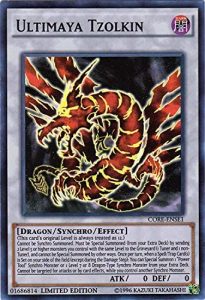 014, Konami released Ultimaya Tzolkin. It's the first monster in the entire game with 0 Level. Interestingly, its summoning condition resembles the summoning condition of Dark Synchro Monsters from the anime (where they subtract the level rather than adding). In 2016, Konami released Phantasmal Lord Ultimitl Bishbaalkin. These two are the only synchro monsters with 0 Level.
014, Konami released Ultimaya Tzolkin. It's the first monster in the entire game with 0 Level. Interestingly, its summoning condition resembles the summoning condition of Dark Synchro Monsters from the anime (where they subtract the level rather than adding). In 2016, Konami released Phantasmal Lord Ultimitl Bishbaalkin. These two are the only synchro monsters with 0 Level.
Super Synchro (2015)
In 2015 s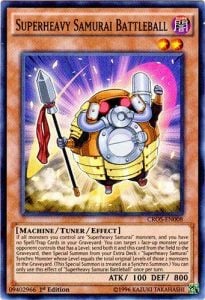 aw the release of Superheavy Samurai Battleball. It's a monster that tunes itself with a monster the opponent controls to perform a Synchro Summon similar to Super Polymerisation. However, it does come with the restriction where the player can only Synchro Summon a Superheavy Samurai monster. Konami hasn't really taken advantage of this gimmick, but they have released monsters with similar effects.
aw the release of Superheavy Samurai Battleball. It's a monster that tunes itself with a monster the opponent controls to perform a Synchro Summon similar to Super Polymerisation. However, it does come with the restriction where the player can only Synchro Summon a Superheavy Samurai monster. Konami hasn't really taken advantage of this gimmick, but they have released monsters with similar effects.
Other monsters that can tune itself with opponent's monsters include Speedroid Maliciousmagnet and Bird of Paradise Lost.
Pendulum Requirement/Support (2015)
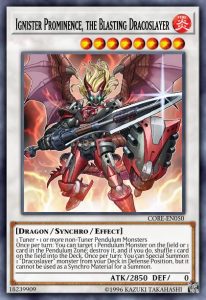 Ignister Prominence, the Blasting Dracoslayer debuted in 2015. It's the first monster that requires a Pendulum Monster as a synchro material. It's also the first Synchro monster to support Pendulum Monsters. The only other monster in the game that requires a pendulum monster as a Synchro material is Supreme King Dragon Clear Wing.
Ignister Prominence, the Blasting Dracoslayer debuted in 2015. It's the first monster that requires a Pendulum Monster as a synchro material. It's also the first Synchro monster to support Pendulum Monsters. The only other monster in the game that requires a pendulum monster as a Synchro material is Supreme King Dragon Clear Wing.
Other Synchros have since been released that supports Pendulum. These cards are Odd-Eyes Meteorburst Dragon, Nirvana High Paladin and D/D/D Super Doom King Bright Armageddon.
Pendulum Tuner (2015)
In 2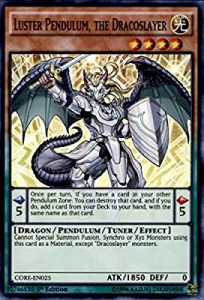 015, Konami released Luster Pendulum, the Dracoslayer. It's the first Pendulum Tuner. During the Arc-V era, Konami released several Tuners that are Pendulum monsters. However, due to Pendulum monsters having the ability to recur themselves back onto the field, Konami has placed conditions on Pendulum Tuner monsters that prevent the player from recurring them. For example, Nobledragon Magician shuffles itself back to the Deck, and other Pendulum Tuners often banish itself after being used for a Synchro Summon.
015, Konami released Luster Pendulum, the Dracoslayer. It's the first Pendulum Tuner. During the Arc-V era, Konami released several Tuners that are Pendulum monsters. However, due to Pendulum monsters having the ability to recur themselves back onto the field, Konami has placed conditions on Pendulum Tuner monsters that prevent the player from recurring them. For example, Nobledragon Magician shuffles itself back to the Deck, and other Pendulum Tuners often banish itself after being used for a Synchro Summon.
Some Pendulum Tuners are White Wing Magician, Speedroid Dominobutterfly, etc.
Phantom Synchro Summon (2016)
Phantom Synchro Summoning is a term coined from the anime by Crow in the Arc-V anime. The process involves tuning monsters on the field to Synchro Summon a Synchro Monster from the Graveyard. Blackwing - Gofu the Vague Shadow is the only monster that can Synchro Summon a monster from the Graveyard using materials on the field. However, a similar effect debuted in the anime in 2009 with the spell card, Shining Rebirth, used by Aki Izayoi.
Pendulum Synchro (2016)
In 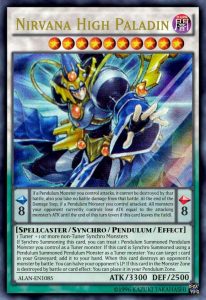 2016, Konami released Nirvana High Paladin. It's the first Pendulum Synchro monster in the game. Being a Synchro Pendulum monster, it first exists in your Extra Deck. When it gets destroyed, instead of going to the Graveyard or Extra Deck, the player can place this game onto the Pendulum Zone.
2016, Konami released Nirvana High Paladin. It's the first Pendulum Synchro monster in the game. Being a Synchro Pendulum monster, it first exists in your Extra Deck. When it gets destroyed, instead of going to the Graveyard or Extra Deck, the player can place this game onto the Pendulum Zone.
Konami has since released two more Pendulum Synchro monsters including Clear Wing Fast Dragon, Odd-Eyes Wing Dragon and D/D/D Super Doom King Bright Armageddon.
Fusion Tuner (2017)
Konami released Sea Monster of Theseus in 2017. It's a normal Fusion monster that is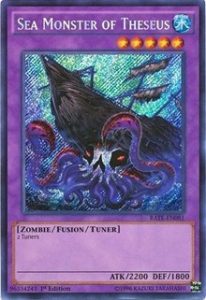 also a Tuner Monster. Now being a Level 5 Fusion monster allows the player to cheese it out with Instant Fusion. Sea Monster of Theseus is the first and so far the only Fusion monster that is also a Tuner monster.
also a Tuner Monster. Now being a Level 5 Fusion monster allows the player to cheese it out with Instant Fusion. Sea Monster of Theseus is the first and so far the only Fusion monster that is also a Tuner monster.
Link Support
In 2017, MR4 did a lot of damage to Synchro decks. To help synchro decks, Konami released Crystron Halqifbrax which is the first Link Monsters to speed up Synchro Summoning.
Other Link Monsters with effects that supports Synchro Monster include Junk Connector, Yuki-Onna, the Ice Mayakashi, Crossrose Dragon, etc.
Treat itself as a Tuner (2017)
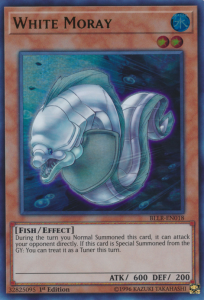 White Moray debuted in 2017. It's a Level 2 Fish-Type monster that has an effect that treats itself as a Tuner if it's revived from the Graveyard. This is actually the gimmick for the "White" card series.
White Moray debuted in 2017. It's a Level 2 Fish-Type monster that has an effect that treats itself as a Tuner if it's revived from the Graveyard. This is actually the gimmick for the "White" card series.
Other monsters with similar effects include White Stingray and Red Potan.
Supporting Links (2018)
20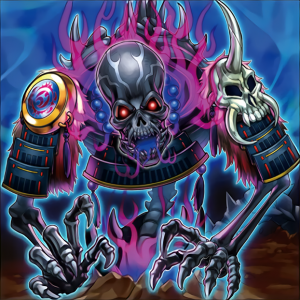 18 saw the release of Gashadokuro, the Skeletal Mayakashi. As this was during MR4, many synchros released in this era are meant to play alongside Link Monsters. Due to this, Gashadokuro, the Skeletal Mayakashi has an effect that supports Link Monsters.
18 saw the release of Gashadokuro, the Skeletal Mayakashi. As this was during MR4, many synchros released in this era are meant to play alongside Link Monsters. Due to this, Gashadokuro, the Skeletal Mayakashi has an effect that supports Link Monsters.
Other Synchro monsters released that supports Link monsters are Cyberse Quantum Dragon and Borreload Savage Dragon.
Triple Tuning (2019)
Ko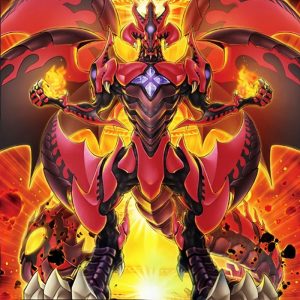 nami released Red Supernova Dragon in 2019. It's a Synchro Monster that requires the player to perform a Triple Tuning (Unofficial Term). This means players have to use three Tuners to Synchro Summon this monster. As of now, this is the only Synchro in the game that requires the player to use three Tuners to perform a Synchro Summon.
nami released Red Supernova Dragon in 2019. It's a Synchro Monster that requires the player to perform a Triple Tuning (Unofficial Term). This means players have to use three Tuners to Synchro Summon this monster. As of now, this is the only Synchro in the game that requires the player to use three Tuners to perform a Synchro Summon.
Dark Synchro Monsters (ANIME) (2008)
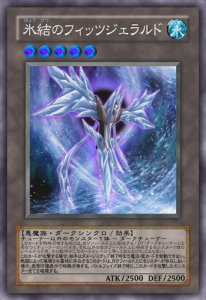 In the 5D Anime, Dark Signers focused on a distinct type of Synchro Summoning known as Dark Synchros. Dark Synchros first debuted in episode 27 in 2008. These synchros have a black border and negative Levels. Unlike normal Synchro, rather than adding the levels of the synchro materials together, Dark Synchro involves subtracting the level of the non-tuner with that of a Dark Tuner. All Dark Synchros from the anime were made into normal monsters with convoluted summoning requirement. As of now, none of the Dark Tuners used in the anime has been adapted to the real-life game.
In the 5D Anime, Dark Signers focused on a distinct type of Synchro Summoning known as Dark Synchros. Dark Synchros first debuted in episode 27 in 2008. These synchros have a black border and negative Levels. Unlike normal Synchro, rather than adding the levels of the synchro materials together, Dark Synchro involves subtracting the level of the non-tuner with that of a Dark Tuner. All Dark Synchros from the anime were made into normal monsters with convoluted summoning requirement. As of now, none of the Dark Tuners used in the anime has been adapted to the real-life game.
Dark Synchros include Moon Dragon Quilla, Frozen Fitzgerald, Dark Diviner, etc.
Harmonic Synchro Fusion (ANIME) (2016)
In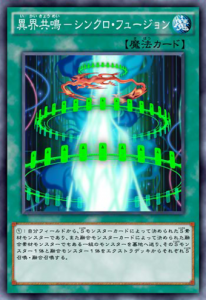 the Arc-V Anime, the character Sergey played a spell card known as Harmonic Synchro Fusion in an episode from 2016. The spell card simultaneously Fusion Summon and Synchro Summon both a Fusion and Synchro monster by sending a tuner and non-tuner materials to the graveyard. We have yet to see this gimmick adapted to the real-life game.
the Arc-V Anime, the character Sergey played a spell card known as Harmonic Synchro Fusion in an episode from 2016. The spell card simultaneously Fusion Summon and Synchro Summon both a Fusion and Synchro monster by sending a tuner and non-tuner materials to the graveyard. We have yet to see this gimmick adapted to the real-life game.




